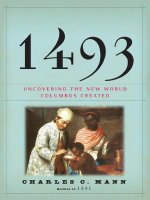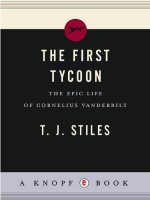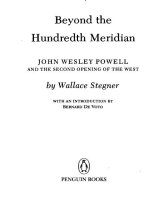Wallace earle stegner beyond the hundredth meridian est (v5 0)
Bạn đang xem bản rút gọn của tài liệu. Xem và tải ngay bản đầy đủ của tài liệu tại đây (7.02 MB, 364 trang )
Table of Contents
PENGUIN BOOKS
Title Page
Copyright Page
Dedication
Introduction
I - THE THRESHOLD
II - THE PLATEAU PROVINCE
III - BLUEPRINT FOR A DRYLAND DEMOCRACY
IV - THE REVENUE OF NEW DISCOVERY
V - THE OPPORTUNITY
VI - THE INHERITANCE
NOTES
INDEX
PENGUIN BOOKS
BEYOND THE HUNDREDTH MERIDIAN
Wallace Stegner (1909-1993) was the author of. among other novels, Remembering Laughter, 1937;
The Big Rock Candy Mountain, 1943; Joe Hill, 1950; All the Little Live Things, 1967
(Commonwealth Club Gold Medal); A Shooting Star, 1961; Angle of Repose, 1971 (Pulitzer Prize,
1972); The Spectator Bird, 1976 (National Book Award, 1977); Recapitulation, 1979; and Crossing
to Safety, 1987. His nonfiction includes Beyond the Hundredth Meridian, 1954; Wolf Willow, 1963;
The Sound of Mountain Water (essays), 1969; The Uneasy Chair: A Biography of Bernard DeVoto,
1974; and Where the Bluebird Sings to the Lemonade Springs: Living and Writing in the West,
1992. Three of his short stories have won O. Henry prizes, and in 1980 he received the Robert Kirsch
Award from the Los Angeles Times for his lifetime literary achievements. His Collected Stories was
published in 1990. ,
PENGUIN BOOKS
Published by the Penguin Group
Penguin Group (USA) Inc., 375 Hudson Street, New York, New York 10014, U.S.A.
Penguin Group (Canada), 90 Eglinton Avenue East, Suite 700, Toronto,
Ontario, Canada M4P 2Y3 (a division of Pearson Penguin Canada Inc.)
Penguin Books Ltd, 80 Strand, London WC2R 0RL, England
Penguin Ireland, 25 St Stephen’s Green, Dublin 2, Ireland (a division of Penguin Books Ltd)
Penguin Group (Australia), 250 Camberwell Road, Camberwell,
Victoria 3124, Australia (a division of Pearson Australia Group Pty Ltd)
Penguin Books India Pvt Ltd, 11 Community Centre, Panchsheel Park, New Delhi — 110 017, India
Penguin Group (NZ), cnr Airborne and Rosedale Roads,
Albany, Auckland 1310, New Zealand (a division of Pearson New Zealand Ltd)
Penguin Books (South Africa) (Pty) Ltd, 24 Sturdee Avenue,
Rosebank, Johannesburg 2196, South Africa
Penguin Books Ltd, Registered Offices: 80 Strand, London WC2R 0RL, England
First published in the United States of America by Houghton Mifflin Company, 1954
Published in Penguin Books 1992
30 29
Copyright Wallace E. Stegner, 1953, 1954
All rights reserved
eISBN : 978-1-101-07585-2
Printed‘in the United States of America
The scanning, uploading and distribution of this book via the Internet or via any
other means without the permission of the publisher is illegal and punishable by law.
Please purchase only authorized electronic editions, and do not participate in or encourage
electronic piracy of copyrighted materials. Your support of the author’s rights is appreciated.
For Bernard DeVoto
Dear Benny:
This is a book in the area of your vast competence, one that you might have written more
appropriately and certainly more authoritatively than I. It is dedicated to you in gratitude for a
hundred kindnesses, the latest of which is the present introduction, but the earliest of which goes back
nearly twenty years. I could not omit a word of thanks for all this without feeling that I had neglected
the most important as well as the most pleasurable step in the making of this biography.
AUTHOR’S NOTE
THIS BOOK is an attempt to write a biography that is the history not of a personality but of a career.
I am not interested in Major Powell’s personality, though that is generally considered the excuse
for a biography, and though he was a man, by the testimony of those who worked with him and loved
him and hated him, electric with energy and ideas. I am interested in him in other ways: As the
personification of an ideal of public service that seems peculiarly a product of the American
experience. As the source and mouthpiece of ideas three quarters of a century ahead of their possible
fulfillment, yet rooted in that same American experience. As the father of government bureaus farreaching in their own effects and influential in the models they provided for other and later
government agencies. Above all, as a champion and an instrument of social understanding and social
change. Like Lester Ward, his one-time employee and firm friend, Major Powell repudiated that
reading of Darwinism which made man the pawn of evolutionary forces. In his view, man escaped the
prison in which all other life was held, because he could apply intelligence and will to his
environment and bend it.
In these pages I have dwelt somewhat long on an early and relatively unimportant, though
adventurous, episode: the running of the Colorado River. I have done so because though Powell’s
later activities were of much greater national importance, the river journey was symptom and symbol.
Though some river rats will disagree with me, I have been able to conclude only that Powell’s party
in 1869 survived by the exercise of observation, caution, intelligence, skill, planning — in a word,
Science. A man or a civilization could do the same. Major Powell’s attempts to impose order on
whatever he touched, and especially on the development of the western states whose problems he
knew as no one in his time knew them, are the real subject of this book.
His understanding of the West was not built on a dream or on the characteristic visions of his time,
for on one side he was as practical as a plane table. The mythologies of the seventies and eighties had
as little hold on him as the mythological tales of Hopi or Paiute: he knew all about the human habit of
referring sense impressions to wrong causes and without verification. His faith in science was a faith
in the ultimate ability of men to isolate true — that is, verifiable — causes for phenomena. Also, he
knew a good deal about the human habit of distorting facts for personal gain, and he fought western
land interests and their political hatchet-men for years, out of no motive but to see truth and science
triumph and the greatest good come to the greatest number over the greatest period of time, according
to the American gospels.
More clearly than most of his contemporaries he demonstrated that fundamental affinity between
Democracy and Science that made America after the Civil War, in spite of scandal and graft and
unprecedented venality, one of the exciting and climactic chapters of history both intellectual and
social. He was one of those who in his education and in his confirmed beliefs seemed the culmination
of an American type, though his own family arrived in America barely in time for him to be born here.
Also, he was one of the illustrious obscure who within the framework of government science
achieved unusual power. He did much solid good because he combined with personal probity an
ability to deal with politicians. And if he was more optimistic about the future of America and the
world than is now fashionable, a review of his career reveals that a large amount of his work both for
science and for democracy has not only lasted but has generated more of the same. We have gone a
good long way toward his principal recommendations with regard to the West; three generations after
some of those plans were first proposed, they seem of an extraordinary prescience.
All of which is to say that though someone like Clarence King may warrant a biography because of
his personality, his wit, the brilliance of his conversation and the glitter of his circle, Powell’s effect
upon his country was that of an agent, or even of an agency. I have tried to treat him accordingly.
In the preparation of this biography I have benefited from the help and advice of scores of
individuals and organizations. Some of the work has been done under grants from the Milton Fund of
Harvard University, the Henry E. Huntington Library and Art Gallery, and the John Simon
Guggenheim Memorial Foundation. The American Philosophical Society has kindly helped with
microfilm problems. Among librarians I have yet to find a surly or unhelpful individual: I think
librarians will inherit the earth. And the list of those to whom I owe a debt of gratitude is appended
here, not to form a cordon through which a reader has to break to get at Powell, but as an inducement:
If such as these have been interested in him and his work, he must be worthy of attention.
For kindness and assistance of every sort, I am especially grateful to Bernard DeVoto of
Cambridge, Massachusetts; Henry Nash Smith of the University of California; Dale L. Morgan of Salt
Lake City; Francis Farquhar, George R. Stewart, Otis Marston, and Paul Taylor of Berkeley,
California; William Culp Darrah of Gettysburg, Pennsylvania; Lindley Morris of Bloomington,
Illinois; Charles Kelly of Fruita, Utah; J. C. Bryant, Superintendent of the Grand Canyon National
Park; the late Norman Nevills of Mexican Hat, Utah; Professor Robert Taft of the University of
Kansas; Beau mont Newhall of Eastman House, Rochester, New York; Ansel Adams of San
Francisco; Paul and Frances Judge of Grand Teton National Park, Wyoming; Struthers and Katherine
Burt of Three Rivers Ranch, Moran, Wyoming; Louise Peffer of the Stanford Food Research Institute;
J. O. Kilmartin, Chief of the Map Information Service of the United States Geological Survey;
Matthew Stirling, Paul Oehser, and Miss Mae Tucker of the Bureau of American Ethnology;
Professors Ben Page, J. E. Williams, and the late Bailey Willis of Stanford University, and V. L.
Vander Hoof, formerly of Stanford; Leroy Hafen of the Colorado Historical Society and Marguerite
Sinclair of the Utah State Historical Society; Thomas Manning of Yale University; and by no means
least, the staffs of the libraries where I have had the pleasure of working: Widener Library of
Harvard University; Bancroft Library, University of California; the Stanford University Library and
the Branner Geological Library, Stanford University; the Henry E. Huntington Library; the National
Archives, the United States Geological Survey, and the Bureau of American Ethnology in Washington;
the New York Public Library; and the McClean County Historical Society of Bloomington, Illinois.
Thanks are due to the Pacific Spectator for the right to reprint the chapter “Adding the Stone Age
to History” in Part IV, and to the Western Humanities Review for the chapter on “Names” in Part II.
ILLUSTRATIONS
FOLLOWING PAGE 92
THE CANYON COUNTRY
The Artists View
1. The popular notion of a canyon. Black Canyon, by Baron F. W. von Egloffstein.
2. The stunned imagination. Egloffstein’s “Big Canyon,” first picture of the Grand Canyon ever
made.
3. The romantic imagination. Gilbert Munger’s chromolith, “Canyon of Lodore.”
4. The footsteps of history in a land of fable. El Vado de Los Padres, by John E. Weyss.
5. An able painter meets a great and difficult subject. “The Transept,” by Thomas Moran.
6. Art without metaphor. The Grand Canyon country, by William Henry Holmes.
7. “A great innovation in natural scenery.” Another view of the Grand Canyon country by
William Henry Holmes.
8. Art and record. Photograph by E. O. Beaman; drawing by Thomas Moran.
THE CANYON COUNTRY
The Camera’s View Portraits
1. Marble Canyon, photographed by J. K. Hillers.
2. Grand Canyon above Lava Falls.
3. The mirror case. Major Powell and a Ute woman.
4. Picturesque America, 1873. Thomas Moran and his writer Colburn, on Moran’s first trip to
the Grand Canyon country.
INTRODUCTION
A BOOK called The Growth of American Thought was awarded the Pulitzer Prize for history in
1944. At the end of a chapter on “The Nature of the New Nationalism” the central figure of Mr.
Stegner’s book makes a momentary appearance. A passage which all told is nearly two pages long is
discussing “the discovery of the West by a group of scientists who revealed it to the rest of the
country.” (They revealed it, we are to understand, primarily as interesting scenery.) A paragraph
pauses to remark that at the time these scientists made their discovery, the frontier was vanishing but
it had “left distinctive traces on the American mind through its cult of action, rough individualism,
physical freedom, and adventurous romance.” Here are four fixed and indestructible stereotypes
about the West, all of them meaningless. No wonder that on the way to them Mr. Stegner’s subject is
dismissed with a sentence which records that “the ethnologist and geologist, John Powell, who
explored the Colorado River, the Grand Canyon, and the homeland of Indian tribes of the Southwest,
promoted extremely important geological surveys for the federal government.” In his bibliographical
notes the historian of American thought adds, “Major John Powell’s Exploration of the Colorado
River of the West and Its Tributaries is a classic.”
Thus “John Powell” was an explorer who embraced the cult of action, whatever that may be, and
went down the Colorado and wrote an adventure story. He also had something to do with geological
surveys which were “extremely important” but not important enough to be specified. Our historian
perceives in them nothing that bears on the growth of American thought. Nor does he mention the
classic which Powell wrote, Report on the Lands of the Arid Region of the United States. Indeed
nothing suggests that he has heard of it. It states, and states systematically for the first time, the
conditions that control human life and society in forty per cent of the area of the United States. But
because the historian of thought approaches the West with a handful of clichés, the conditions of life
and society are not important. What counts is the book he names, an “adventurous romance.”
Which is fair enough and no doubt inevitable. True, one historian who understood John Wesley
Powell and his importance, Mr. Walter Prescott Webb, had discussed him at length before the one I
have quoted wrote his book. But most of his colleagues had not even heard of Powell in 1944, and
still haven’t. This un-awareness represents a serious gap in historical thinking — which is the only
reason for quoting a prizewinning book here. Otherwise it would be enough to say that Powell was
one of those powerfully original. and prophetic minds which, like certain streams in a limestone
country, sink out of sight for a time to reappear farther on. It will not do to sum up so briefly. For the
reason historians have ignored Powell is that the preconceptions with which they have approached
the area Powell figures in correspond exactly to the misconceptions with which the American people
and their government approached the West.
Powell’s importance is that seventy-five years ago he pierced through those misconceptions to the
realities. His career was an indomitable effort to substitute knowledge for the misconceptions and to
get it acted on. He tried to repair the damage they had done to the people and the land and to prevent
them from doing further damage. He tried to shape legal and political and social institutions so that
they would accord with the necessities of the West. He tried to conserve the West’s natural wealth so
that it could play to the full its potential part in the future of the United States. He tried to dissipate
illusions about the West, to sweep mirage away. He was a great man and a prophet. Long ago he
accomplished great things and now we are beginning to understand him ... even out west.
That is the burden of Mr. Stegner’s memorable book. My part here is to explain why writers of
history have for so long failed to understand the massive figure of John Wesley Powell and therefore
have failed, rather disastrously, to understand the fundamental meaning of the West in American
history.
One of the reasons for that failure is beyond explanation: the tacit classification, the automatic
dismissal, of Western history as merely sectional, not national, history. No such limitation has been
placed on the experience of the American people in New England, the South, or the Middle West.
These sections are taken to be organic in the United States and cannot safely be separated from their
functional and reciprocal relationships. When you write Southern history in the round you must deal
with such matters as, for instance, the cotton economy, the plantation system, slavery, States’ rights,
the tariff, secession, the Civil War, and Reconstruction. They are so clearly national as well as
Southern in implication that it would be impossible to write about them without treating them in
relation to the experience of the nation as a whole. The same statement holds for the historical study
of, say, Southern institutions, Southern politics, and Southern thinking — to ignore their national
context would clearly be absurd. Southerners too are acquainted with “action” if not a cult of action,
and are known to value “individualism” if not a rough kind of it. We may observe, even, that the
South has had some awareness of “physical freedom” and “adventurous romance.” But an intellectual
historian would not write a summary which implied that history need inquire no further — would not
dismiss Jefferson with a sentence about his governorship of Virginia or Calhoun with one about his
term in the legislature of South Carolina.
The experience of the West is just as inseparable from the central energies of American history.
Any major Western topic, or any commonplace Western phenomenon, involves those energies the
moment it is glanced at. Thus a favorite garment in the West (as in rural places throughout the United
States) is a shirt whose trade name is Big Yank. It is a cotton shirt — made of a fiber once grown
only in the South but now grown competitively in the West. It is a manufactured article — a product
of industry located outside the West. So it cannot safely be dissected out from the national system.
And the more you look at it, the more clearly you see that this involvement is complex. You encounter
the mercantile-colonial status of the Western economy, the drainage of Western wealth eastward, the
compensatory process of federal benefactions, preferential freight rates, and myriad concrete facts
related to these — all national in implication. Make the shirt a woolen one and you bring in the tariff,
absentee ownership of the West, Eastern control of Western finance, and the stockgrowing portion of
Western agriculture. And if you will look at the woolen shirt just a little longer it will lead you
straight to the basic conditions of the West.
Unless you are deflected or dazzled by its “adventurous romance.” Or by your historical
preconceptions.
The West was the latest and most adventurously romantic of out frontiers, and its history has been
written, mostly, as frontier history. When the word “frontier” is used in history it has, to begin with,
been raised to a tolerably high degree of abstraction. And its inherent abstractness has been almost
immeasurably increased by a hypothesis which has dominated much writing about the West and has
colored almost all of it, Frederick Jackson Turner’s theory about the function of “the frontier” in
American life. That theory has, I suppose, begotten more pages of American history than any other
generalization. Till recently no one dreamed of writing about the West without its help. Indeed its
postulate of a specific kind of “frontier” independence, which it derives from the public domain and
which it calls the principal energy of American democracy, has heavily buttressed our illusions about
the West. So our problem here exists in a medium of pure irony. For, to whatever degree the Turner
hypothesis may be applicable to American experience east of the 100th meridian, it fails almost
altogether when applied to the West. The study of a single water war, in fact of a single irrigation
district, should reveal its irrelevance. Indeed as one who has written extensively of our sacred
Western symbol, the covered wagon, I have frequently found myself wondering if the study of a single
wagon train ought not to suffice.
But two other facts affect our problem more. In general, historians have been content to postulate
that American institutions, orientations, and habits of thought which developed east of the 100th
meridian maintained their form and retained their content after reaching the West, whereas in fact a
good many important ones did not. In the second place, historians have generally been ignorant of or
incurious about natural conditions that determine life in the West, differentiate it from other sections,
and have given it different orientations. Since the importance of John Wesley Powell is entirely
related to those differences, historians have naturally had no reason to perceive it. Presumably anyone
nowadays is well enough informed to understand that the engaging nonsense of William Gilpin, which
Mr. Stegner uses so effectively to illuminate Powell’s achievements, is and always was nonsense.
But the point is that anyone who is not well grounded in Western geography, topography, and climate
could easily be led to dismiss Powell as precisely the kind of eccentric Gilpin was.
Well, there isn’t much rain out west. There is not enough rain to grow crops and so additional
water has to be brought to them for irrigation. The additional water falls as snow on the mountains, it
melts, and it flows down the brooks to the creeks and down them to the rivers. If you build dams, you
can hold the runoff for use when and where it is needed. Then if you construct systems of canals —
increasingly complex systems as you take the melted snow farther — you can bring the water to town
mains and to the fields that won’t grow crops without it. The historical process which we call the
westward movement shattered against these facts. Neither hope nor illusion nor desire nor Act of
Congress could change them in the least. But they were even harder for the American people to accept
than they have been for historians to understand.
There is no need to describe how the “quarter-section” acquired mystical significance in American
thinking — the idea that 160 acres were the ideal family-sized farm, the basis of a yeoman
democracy, the buttress of our liberties, and the cornerstone of our economy. It was certainly true,
however, that if you owned 160 acres of flat Iowa farmland or rolling Wisconsin prairie, you had, on
the average, a farm which would support your family and would require all its exertions to work. So
the quarter-section, thought of as the proper homestead unit, became the mystical one. But in the arid
regions 160 acres were not a homestead. They were just a mathematical expression whose meanings
in relation to agricultural settlement were disastrous.
To begin with, what kind of land? A hundred and sixty acres of redwood or Douglas fir or Western
white pine never could be a homestead — but they were a small fortune. Hence the personal and
corporate timber frauds which stand high in the record of our national corruption. A hundred and sixty
acres of arid range land could not provide forage for enough stock to support a family. Hence two
kinds of land fraud, on a large scale by wealthy or corporate stockgrowers to acquire big ranges, on a
small scale by poor individuals trying to acquire the self-supporting homesteads that they could not
get legally. What about 160 acres of valley farmland with the rich mineral soil of the West and
capable of being irrigated? Two considerations: to irrigate so large a tract would usually cost more
than an individual owner could afford, and the farming made possible by irrigation would mostly be
so intensive that so big a farm could not be worked by a single family.
So the land in the arid country had better be classified, and the unit of ownership, the size of the
homestead, had better be adjusted to the realities. Our system had always resisted land-classification
for the public domain — the official ruling that standing timber was not farmland — in the interest of
speculation and graft. But in the arid country not to classify land would on the one hand facilitate
monopolization of land, and on the other hand would perpetuate and institutionalize the bankruptcy of
Western homesteaders. And unless the unit of ownership was changed there would be no way of
squaring either public or private interests with the immutable facts. But both changes would mean
fundamental alteration of our legal and land system, and would produce further changes in many
institutions related to them. The sum of change required was so great that the American mind did not
take it in — and went on believing that there must be some way of licking climate or that climate
would adapt itself to men’s desires. Against this inherited set of mind, the tumultuous and tragic
experience of the West could not prevail.
Again, not only what kind of land but whereabouts? A small holding that included a water source
could prevent access to the basis of life and so would give its owner the usufructs of a much larger
area which he could keep others from owning. Adjoining holdings along a stream could similarly
dominate a much larger area. So at small expense (and by fraud) a corporation could keep individual
stockgrowers from a really vast area it did not own but could thus make use of. Or a corporation
could not only charge its own price for water, that is for life, but could control the terms of settlement
with all that settlement implies. Here was another powerful force making for monopoly and
speculation. Clearly, that is clearly to us now, the West could exist as a democratic society only if the
law relating to the ownership and use of water were changed. The changes required were repugnant
to our legal system and our set of mind, and again the experience of the West produced turbulence but
not understanding.
Moreover, to bring water to land at any distance from the source was an undertaking expensive
beyond the ability of an individual landowner to afford. As the distance increased it would become
expensive beyond the ability first of co-operative groups, then of profit-making corporations, and
finally of the individual states to afford. At the heyday of “individual enterprise” elsewhere in the
United States, therefore, the natural conditions of the West demanded federal action in the
procurement of water. And this was repugnant not only to our set of mind but, especially, to our
mystical vision of the West, the very citadel, so we insisted on believing, of “rough individualism.”
Furthermore, if in large parts of the West the individual landowner required a homestead of at least
four square miles, then the traditional pattern of settlement would result in his living in fearful
isolation from his kind. Loneliness, hardship, and social deterioration would inevitably follow.
(Which is the history of the high plains down to the automobile and the coming of good roads.) What
the Western realities demanded was not the ranch pattern of the Dakotas but the village pattern of the
Spanish-American Southwest and of Mormon Utah. And in the arid region the traditional political
organization within the states, by counties, would be cumbersome, illogical, and intolerably
expensive. Far better to avoid such irrational units and to organize politically in accord with the
Western realities, by river valley or watershed.
This does not state all the immutable conditions of the West against which institutions and
eventually ideas shattered but it will do here. The history of the West derives from them — a history
of experience failing to overcome in time our thinking, our illusions, our sentiments, and our
expectations. The results were hardship, suffering, bankruptcy, tragedy, human waste — the
overthrow of hope and belief to a degree almost incredible now, and only now beginning to be
understood in the historical context.
These principles are described and analyzed, and most of the institutional changes necessary to
bring Western society into effective accord with them are stated, in Powell’s Report on the Lands of
the Arid Region of the United States. In fact, they are set forth in the first forty-five pages of that
monumental and astonishing book, a book which of itself opened a new era in Western and in national
thinking. It is one of the most remarkable books ever written by an American. In the whole range of
American experience from Jamestown on there is no book more prophetic. It is a scientific prophecy
and it has been fulfilled — experimentally proved. Unhappily the experimental proof has consisted of
human and social failure and the destruction of land. It is a document as basic as The Federalist but it
is a tragic document. For it was published in 1878 and if we could have acted on it in full,
incalculable loss would have been prevented and the United States would be happier and wealthier
than it is. We did not even make an effective effort to act on it till 1902. Half a century after that
beginning, we are still far short of catching up with it. The twist of the knife is that meanwhile
irreversible actions went on out west and what we did in error will forever prevent us from catching
up with it altogether.
Yet those statements, though true, will not hold of themselves. For meanwhile, before the effective
beginning was made, institutions which Powell founded were amassing the knowledge that made the
beginning possible. And they were steadily changing American opinion as they added to knowledge
— to the treasury of knowledge that is the heritage of all mankind. And they, with what has issued
from them, have steadily changed not only American social and political institutions but the structure
and functions of the government of the United States. Finally, as this change has progressed it has
become a force which, joined with others working in the same direction, has greatly changed our
ideas of what government ought to do and how it should do what it ought.
That story, however, is Mr. Stegner’s book. I began by alluding to a gap in historical understanding
which has caused distortions in the writing of American history. Mr. Stegner has now filled the
central and biggest part of that gap. Henceforth a prizewinning book about American intellectual
history will not dismiss Powell as a believer in the cult of action who wrote an adventure story.
Mr. Stegner’s subject is nineteenth century America and the part the West played in creating
twentieth century America — wherein, how, but most of all why. He has added a basic book to the
small shelf of books that give history basic knowledge of Western experience. As recently as twenty
years ago there were no such histories, at least there were none sound enough and understanding
enough to be used for interpretation. There are just about enough of them now, they have amassed just
about enough basic knowledge, to justify someone in bringing them together to construct a new
general synthesis of American history. Any day now we may expect the appearance of a historian
with a generalizing mind who is bent on achieving a hypothesis about the West in American history
that will square with the facts. When someone achieves it, it will be a more realistic and therefore a
more useful theory than Turner’s.
BERNARD DEVOTO
I
THE THRESHOLD
1. Independence Day, 1868
ON JULY 4, 1868, about the time when Henry Adams was turning back toward New York to face a
new and sharply altered America after ten years of study and diplomacy in the service of the old, two
men who would have been worth his attention as a historian were going about their business on the
western edge of the Great Plains.
One, the Honorable William Gilpin, was at fifty-five a veteran of large actions and an old Western
hand.1 He had been a friend of Andrew Jackson‘s, and Jackson’s personal appointee to West Point;
his brother had been Attorney General in Van Buren’s cabinet. Gilpin himself, blown westward by an
accidental encounter with Frémont’s expedition in 1843, had gone with Frémont as far as Walla
Walla and then continued to Fort Vancouver by himself. He had brought back to Washington the 1844
petition of settlers in the Willamette valley for American occupation, and had become an authority
and adviser on Western affairs to Washington statesmen, including Thomas Benton of Missouri. As a
major in Doniphan’s First Missouri Volunteers he had fought Mexicans in 1846, and later than that he
had joined expeditions against the Comanches and Pawnees. When Abraham Lincoln went to
Washington to face the consequences of his election as President of the United States, William Gilpin
went with him; for weeks he slept in the White House as one of the volunteer bodyguard of one
hundred, a service which he relinquished to become the first territorial governor of Colorado. In that
office he had been active and effective in holding Colorado for the Union, and he had been through all
his life a consistent and impassioned advocate of the imperial dynamism of Old Bullion Benton.
Speaking to the Fenian Brotherhood in the capital of the seven-year-old territory of Colorado on
this Fourth of July, 1868, he repeated and summarized the things he had been saying in speeches and
books since before the Mexican War and would go on saying until his death. It is almost aweinspiring to contemplate this veteran Westerner, with twenty-five years of hard firsthand experience
behind him, as he stands up in the raw frontier town of Denver and looks clear over the continent of
facts and into prophecy.
“What an immense geography has been revealed!” he shouted at the sweating Fenians and their
guests. “What infinite hives of population and laboratories of industry have been electrified and set in
motion! The great sea has rolled away its sombre veil. Asia is found and has become our neighbor....
North America is known to our own people. Its concave form and homogeneous structure are
revealed. Our continental mission is set to its perennial frame....”
Gilpin’s version of America’s continental mission he had already elaborated in 1860, in a book
entitled The Central Gold Region, The Grain, Pastoral, and Gold Regions of North America with
Some New Views of Its Physical Geography and Observations on the Pacific Railroad. He would
reprint it with additions in 1873 as The Mission of the North American People, and extend its ideas
in 1890 in The Cosmopolitan Railway. The Manifest Destiny which he had learned from Benton, and
which was a creed and a policy of his generation, was a passionate vision to Gilpin. He saw the West
through a blaze of mystical fervor, as part of a grand geopolitical design, the overture to global
harmony; and his conception of its resources and its future as a home for millions was as grandiose as
his rhetoric, as unlimited as his faith, as splendid as his capacity for inaccuracy.
All the wishful convictions of his time and place had his credence. The Great American Desert
whose existence had been vouched for by travelers and vaguely indicated on maps at least since the
report of Zebulon Pike in 1810 was waved away with a gesture. The semi-arid plains between the
100th meridian and the Rockies, plains which had barred settlement and repelled Spaniard and
Anglo-American alike, were no desert, nor even a semi-desert, but a pastoral Canaan. Belief in such
a desert, he said, had preceded settlement, the location being put ever farther west like the homeland
of the White Indians, until now it pinched and disappeared before the eyes of gold seekers and
pioneer farmers. Gilpin joined the politicians and the railroads, eager for settlers, in finding most of
the plains region exuberantly arable. He had distinguished corroboration for his belief that artesian
waters would unlock the fertility of the whole subhumid region east of the Rockies, and if he had
chosen to he could have quoted everything from frontier folklore to government geologists in support
of the theory that settlement improved the climate, that in very truth “rain follows the plow.”2
No hindrances to settlement now existed, Gilpin said; the Mississippi Valley which now supported
eighteen million people could easily support eighteen hundred million, ten times the total population
of the Roman Empire under Trajan and the Antonines. On the more westerly plains, though there was
little surface timber, a beneficent Nature had so disposed the rooting system of the low growth that
settlers were able to dig for firewood and find plenty. And on these plains, once the wild herds were
exterminated, three domestic animals could be pastured where one wild one had formerly roamed.
Throughout the vast concave bowl of the continental interior was illustrated the unifying effect of
geography, for here where everything ran toward the center instead of being dispersed and divided by
central mountains, the people could never be divided into a hundred tribes and nations as in Europe,
but must be one. The native race was an illustration: all the tribes from Florida to Vancouver’s Island
exhibited a “perfect identity in hair, complexion, features, religion, stature, and language.” To this
same healthful homogeneity our fortunate geography would within a few generations bring white
Americans also.
But marvelous and fecund as the valley was, the great plateau region, including the parks of the
Rockies, was more wonderful. Superlatives were futile for the description of the salubrity, richness,
health, prosperity, and peace this West offered. The painful struggles of earlier times and harsher
climates would not be found. Even houses were unnecessary, so temperate were the seasons. The
aborigines used none, and Gilpin himself, in six years of living there, had rarely slept under a roof.
(The Mormon handcart companies who starved and froze on the Sweetwater in 1856 might have been
astonished to hear this; likewise the men of Frémont’s 1848 expedition, reduced to the practice of
cannibalism in the Colorado mountains.)
Agriculture was effortless: no forests needed clearing, manual tillage was not required, even the
use of the plow was not essential, so eager were seeds to germinate in this Paradise. As the plains
were amply irrigated by underground and artesian waters, the plateau was watered by mountain
streams of purest melted snow, and to arrange fields for irrigation was no more trouble than fencing,
which the ditches here superseded. No heat or cold, no drouth or saturation, no fickle climate or
uncertain yield, afflicted this extensive region, and no portion of the globe, even the Mississippi
Valley with its potential eighteen hundred millions, would support so dense a population. San Luis
Park would in time become as renowned as the Vale of Kashmir; South Pass would be a gateway
more thronging than Gibraltar. And all up and down the length of the cordillera that stretched through
two continents, the unlimited deposits of precious metals assured the people of a perennial and
plentiful supply of coin. In a moment of caution, keeping his feet on the ground, Gilpin admitted that
there were a few — a very few — patches of gravelly and unproductive soil in the mountain parks,
but he hastened to add that these could be depended upon to contain placers of gold.
Owning a territory that stretched from sea to sea and brought America face to face with Asia on the
West as it was face to face with Europe on the East; possessed of unlimited gold and other resources;
endowed with a population energetic and , enduring, which the peculiar geography of the continent
would soon blend into one people; blessed with a political system divinely appointed to emancipate
the world’s oppressed millions and set an example that would recreate the globe; tested and unified
by the late bloody civil strife, and with a geographical position squarely upon that isothermal zodiac
which had nourished all the world’s great civilizations, America lacked nothing for the most
extravagant future. On the brink of the mountain West (and already past the threshold of the Gilded
Age) Gilpin looked into the sunburst dazzle of Manifest Destiny and panted for words to express his
triumph and his vision.
And he had some justification. West of the hustling capital on Cherry Creek the gulches were
pouring out gold. North of it the Union Pacific tracks had crossed the pass between Cheyenne and
modem Laramie and were approaching the continental divide at Creston. The tracks that had already
surmounted altitudes greater than any railroad had surmounted before would ceremoniously mate with
the Central Pacific rails north of Great Salt Lake on May 10 of the next year. Instantly the hardships of
a continental crossing would be replaced by the luxury of Mr. Pullman’s palace cars, and the
symbolic union at Promontory would convert virtually a whole nation to the optimism of seers like
William Gilpin. The cattle which would replace the buffalo were already coming north from Texas,
beginning the fleeting romantic history of the cowboy West. The buffalo which were to be replaced
were already being hunted to death for their hides or the sport of tourists, and it would not be too
many years before the pioneer farmers of Kansas would make two and a half million dollars simply
by clearing their fields of bones and shipping them east to fertilizer mills. Within five years of the
time Gilpin spoke, literally millions of hides would go east via the Union Pacific, Kansas Pacific,
and Santa Fe.3 The West was ready to welcome its happy settlers.
But on the same day when Gilpin summarized his geopolitical and prophetic extravaganza for the
Fenians, an exploring party was camped a few miles out of Cheyenne, in what would in three weeks
become Wyoming Territory. It included something over a dozen people, among them the wife and
sister of the leader. Some of the rest were college students, some were teachers, some were amateur
naturalists, one or two were merely tourists. All were so recently arrived that the camp was a
disorderly collection of duffle and half-broken mules and half-organized intentions. Backing the
expedition was an assortment of scientific and educational institutions, all in on a penny ante basis:
the Illinois Natural History Society, the Illinois Normal University, the Illinois Industrial University,
and by virtue of some donated instruments and some good advice, the Smithsonian Institution.
Leading the party was a man who before he was through would challenge almost every fact and
discourage every attitude that William Gilpin asserted or held about the West — challenge and attack
them coolly and on evidence — and in place of Gilpin’s come-all-ye frenzy would propose a
comprehensive and considered plan for the opening of the regions beyond the 100th meridian. That
plan, beside Gilpin‘s, would be so sober as to seem calamitous; it would employ consistently what a
recent historian rather unhappily calls “deficiency terminology” 4 when speaking of the West, and it
would be decades before parts of it would get a calm public hearing.
If William Gilpin was enthusiastically part of his time, yapping in the van of the continentally
confident, Major John Wesley Powell was just as surely working against the current of popular
optimism in the policies he developed, and decades ahead of it in his vision. It was to be his
distinction and in a way his misfortune that in an age of the wildest emotionalism and nationalist
fervor he operated by common sense, had a faith in facts, and believed in system. It was also one of
his distinctions that in an age of boodle he would persist in an ideal of public service which most
public men of the time neither observed nor understood.
Major Powell was no pioneer Westerner as Gilpin was. The summer of 1868 was only his second
summer in the West, and he was thirty-four years old to Gilpin’s fifty-five. As yet he was not much of
anything — not much of a scientist, not much of a schoolteacher, not much of an explorer. But to the
problems which the West suggested, and which from this time on absorbed his interest and shaped his
career, he brought eventually science where Gilpin brought mythology, measurement where Gilpin
brought rhetoric; and he brought an imaginative vigor as great as Gilpin’s but much better controlled
and much closer to fact. In his one trip to the Rockies in the summer of 1867 he had learned more
basic truths about them than Gilpin would ever know. By the end of his career he would know the
West as few men did, and understand its problems better than any.
He would know enough to correct Gilpin in all his major assumptions and most of his minor ones.
Even in 1868 he knew enough not to say that “North America is known to our people.” On the maps
he carried there were great blank spaces: in less than a year he would be embarked on an exploration
that would replace hundreds of square miles of cartographical guesswork with information. As part of
his mature work he would plan and begin the systematic mapping of the whole country, a project that
even yet is incomplete and will never be finished as he planned it. Through years of public life he
would resist with all his energy the tide of unreasoning, fantasy-drawn settlement and uncontrolled
exploitation that the Gilpins explicitly or implicitly encouraged. He would continue to believe in a
modified Great American Desert, to talk in “deficiency terms,” to insist that instead of supporting
eighteen hundred million people the Mississippi Valley could be made, in its trans-Missouri reaches,
a barren and uninhabitable wasteland by the methods used to irritate it into fertility. He would protest
the plow that broke the plains, he would deny that rain followed the plow, he would fight Western
Congressmen and Senators and land speculators and dreamers who persisted in the Gilpin belief in
ample artesian water under the Dakota buffalo grass. Instead of taking on faith the existence of
unlimited seams of metals and coal, he would have a large hand in the careful survey of all these
resources, and he would have the vision to add water and grass and land and timber to those limited
and destroyable riches. He would have the courage to seek a revision of the public land laws and a
modification of the sacrosanct freehold of 160 acres to match the conditions of the West, and would
fight for his proposals cunningly and tenaciously. He would labor to conserve the public domain and
to withdraw lands from entry in order to protect for posterity and the public good watersheds and
dam sites and playgrounds. The irrigation which to Gilpin was simpler than building fence would be
a lifelong study to Powell, and he would father a public interest in the subject that would eventually
flower in the Newlands Act of 1902, establishing the Reclamation Bureau which has remade the face
of the West. He would be a prime mover in the establishment of the federal government as the
sponsor of science for the public welfare. Instead of preaching unlimited supply and unrestrained
exploitation he would preach conservation of an already partly gutted continent and planning for the
development of what remained.
And even the matter of racial homogeneity. It is hard to imagine what enthusiasm could have led
Gilpin to say that all of the North American Indians were of one stature, language, complexion,
religion, and culture. A glance at Gallatin’s work would have told him differently; his own
experience with Indians should have forced him to other conclusions. Powell would demonstrate, the
first to bring a comprehensive order and system to the study, that the Indians were on the contrary of
an incredible variety in every way. He would undertake the classification of all the Indian languages,
would study Indian myth and folklore, and would found a government bureau whose whole purpose
was the scientific investigation of that variety, before the tribes were obliterated by the tide of
Gilpin’s settlers. In the course of those ethnological studies, he would contribute to the remaking and
enlarging of the science of cultural anthropology.
But all of these activities, knowledges, and achievements were in the future. On July 4, 1868, they
lay around in Powell’s mind half realized and half intended, as much in need of thought and discipline
and organization as the half-organized camp of the Rocky Mountain Scientific Exploring Expedition.
2. The Dynamics of a Homemade Education
THE BOY HENRY ADAMS, appraising the careers that were open to him, felt that of all the
possibilities, the West offered him least. “Neither to a politician nor to a business-man nor to any of
the learned professions did the West promise any certain advantages, while it offered uncertainties in
plenty.” 1 Adams could not have been expected to know in 1854 the shape of things to come, but the
reminiscent Adams who was writing his Education in 1905 might have admitted that to certain
politicians — Lincoln, Grant, and Garfield among them — as well as to certain businessmen —
Miller and Lux, Isham, Henry Villard, Leland Stanford — as well as to numerous teachers, preachers,
writers (Twain, Howells, Bret Harte, Hamlin Garland, Edward Eggleston) — the West had offered
not merely opportunity but golden opportunity. One did not have to like everything the West brought
into the nation’s life to be aware that it had brought something, even that long before 1905 it had come
to have a certain dominance in national affairs. Yet Adams, forgetful or not of how the nation’s center
of gravity had shifted from the Quincy and Beacon Hill of his boyhood, was certainly right in not
going west to grow up with the country. Whatever his education had prepared him for, it had not
prepared him for that. That took an education of a special kind. To grow up with the West, or to grow
with and through it into national prominence, you had to have the West bred in your bones, you
needed it facing you like a dare. You needed a Western education, with all the forming and shaping
and the dynamics of special challenge and particular response that such an education implied.
The thing that many western boys called their education would have seemed to Adams a
deprivation, so barren was it of opportunities and so pitiful were its methods and equipment.
Considered in any way but in terms of its results in men and women, it was a deprivation. But the men
it produced over a period of several generations showed such a family resemblance that until
immigration drowned them under they constituted a strong regional type, and their virtues as
exemplified in a Lincoln or a Mark Twain force the conclusion that this crude society with its vulgar
and inadequate culture somehow made noble contributions to mankind. John Wesley Powell, without
being a Lincoln or a Mark Twain, was of that persuasion, one of a great company. It is worth looking
for a moment at how he was made.
It is easy enough to summarize: he was made by wandering, by hard labor, by the Bible, by an
outdoor life in small towns and on farms, by the optimism and practicality and democracy of the
frontier, by the occasional man of learning and the occasional books he met, by country schools and
the ill-equipped cubs or worn-out misfits who taught them, by the academies and colleges with their
lamentable lacks and their industry and their hope, by the Methodism of his father and the prevailing
conviction that success came from work and only to the deserving. If there were not many
opportunities, if the cultural darkness was considerable, it was also true that in that darkness any little
star showed as plainly as a sun.
A homemade education did something to the people who acquired it, and a homemade education
was not the exclusive invention of the western settlements. Any rural area, once frontier, retained
some of the stamp: the boyhood of a Thurlow Weed or a John Burroughs or a Jay Gould in upstate
New York was not greatly different from the boyhood of a Lincoln or a Garfield or a John Muir in the
Midwest. But in the Midwest, over immense regions of a peculiar homogeneity in climate, geography,
people, and economic status, the homemade education was typical, and it was made more typical by
the way in which successive westering waves repeated the whole process in new country. Ohio and
Kentucky repeated the backwoods experience of Massachusetts and New York and Pennsylvania;
Indiana repeated Ohio; Illinois and Wisconsin and Michigan repeated Indiana; Iowa and Minnesota
and Missouri repeated Illinois and Wisconsin; the Dakotas and Nebraska and Kansas repeated, or
tried to repeat, Iowa and Minnesota. 2
The bearded, one-armed young man who commanded the Rocky Mountain Exploring Expedition,
and who had acquired the lifelong title of Major in the same volunteer service that cost him his arm,
was almost classically a product of that special frontier education. His character, his ideas, his very
weaknesses and his peculiar strengths derived from a social and intellectual climate nearly
rudimentary, nearly unformed, but of a singularly formative kind. He is not comprehensible as man or
as career except in the context given memorable expression by Lincoln, and containing, among
Powell’s own contemporaries, such distinguished names as Garfield, Mark Twain, Howells,
Eggleston, Muir, Garland and Lester Ward. These, and many others like them, at once expressed and
helped to shape the emerging West. The education of John Wesley Powell is less interesting as a
personal than as a regional experience. 3
Wandering was a part of it, and the wandering led always west. Born in Mount Morris, New York,
the eldest son of an immigrant Wesleyan preacher, young Powell spent his boyhood in Jackson, Ohio,
near Chillicothe, and knew what it was to be stoned as an abolitionist for his father’s sake, and
learned something of the southern Ohio country from the reports his father brought home from the
circuit, and watched a town grow up from raw beginnings around him, and had some chance to
observe leading men of the town and region. By the time he was twelve he was adding the rural
experience to that of the small town, taking over the major responsibility for a frontier farm in
Walworth County, Wisconsin, southwest of Milwaukee. By the time he was eighteen he was helping
his family to move across into Bonus Prairie, Illinois, and was ready himself to break loose on a
series of summer trips and summer jobs that took him from St. Paul to New Orleans, from Pittsburgh
to St. Louis, across Michigan, Wisconsin, Missouri, up and down the Mississippi and its tributary
rivers. The principal purpose of those trips was amateur natural history, but they were adventure too
— and education. The Civil War could hardly be said to have dragged him away from home; his
home had been hardly more than a wharf to tie his boat to for years. And no sooner was the war over
than his itchy foot led him west. His migratory family finally came to rest, long after Powell had
broken away, in Em poria, Kansas.
An acquaintance with books and learning was not a thing that a frontier boy like Powell could take
for granted; he had to seize it as he could. Abe Lincoln said it for every such boy with brains and
dreams in his head: “The things I want to know are in books; my best friend is a man who’ll git me a
book I ain’t read.” A frontier boy with a lust for books was not choosy. It is hard, in an age with more
books than it wants, to comprehend the enduring passion for reading that kept Lincoln up half the night
with his bushy head almost in the fire, and led John Muir to rise at one o‘clock in the morning to read
and work on inventions, and induced Powell, hauling grain to market from the Walworth County farm,
to put under the wagon seat any books he happened to have available, to be read on the slow tedious
road. A frontier child who liked to read read what he could lay his hands on, and he laid hands on
some peculiar things and in odd quarters. The boy who got a homemade education rarely could buy
books until he was well grown, though Edward Eggleston’s father took the precaution of providing in
his will for a library for the use of his sons. Generally a boy borrowed his reading, and generally
there was someone whom accident or ambition had tossed out on the frontier who brought his love of
books and some of the books themselves to the wilderness. Inferretque deos Latio. Acquiring
learning in the rural Midwest was like an elaborate egg-hunt — but the rules were fair; there were
always eggs if you hunted long and hard enough. Somebody always turned out to have a book you
hadn’t read.
Quite as often, somebody in town or within reach turned out to have some sort of intellectual or
professional or scientific interest or capacity, too, and that when it showed was a very bright star to
tell direction by. In an extraordinary number of cases that first man of learning or enthusiasm that a
frontier boy encountered gave his life a twist that it never outgrew. It happened that when Lincoln
walked twenty miles to borrow books in Rockport, he borrowed them from Pitcher, and Pitcher was a
lawyer. It happened too that from Dave Turnham, the constable at Pigeon Creek, he borrowed The
Revised Laws of Indiana, adopted and enacted by the general assembly at their eighth session. To









